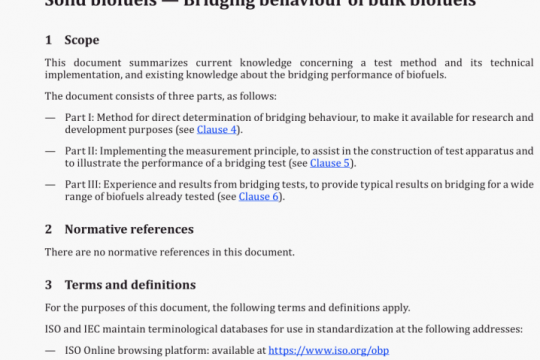ISO/TS 21975 pdf free download
ISO/TS 21975-2020 pdf free download.Nanotechnologies – Polymeric nanocomposite films for food packaging with barrier properties一 Specification of characteristics and measurement methods.
4.2 Nano-object (essential characteristics)
4.2.1 Size and size distribution
4.2.1.1 General
The barrier properties of polymeric nanocomposite film are sensitive to the size of nano-objects incorporated into the polymeric matrix.
Nano-objects are three-dimensional objects with different shapes. It is impossible to represent the size of nano-object using a single number. Consequently, in most techniques it is assumed that the shape is spherical because a sphere is the shape that can be represented by a single number, its diameter (see
ISO 19430:2016).
A test specimen for measurements of size and size distribution is taken from the nano-object raw material sample and a suspension is prepared.
The average size of a nano-object shall be measured using an appropriate measurement method and, if possible, specifying if the nano-object measured is primary or secondary (agglomerate). The measurement results shall be expressed in the unit of nm.
An appropriate measurement method from among SAXS, electron microscopy (TEM and SEM), DLS, AFM and PTA is recommended to be taken for measuring the average diameter of nano-objects.
NOTE 1 In most cases, the measured size can be of a secondary nano-object because of agglomeration. To inhibit agglomeration, an appropriate sample preparation is necessary.
NOTE 2 Ultra-sonication of the suspension containing a nano-object is an appropriate method before size measurement by the above mentioned methods.
4.2.1.2 Small angle X-ray spectroscopy
The size of nano-objects in liquid medium can be measured via SAXS. The SAXS technique is used to measure the primary and secondary nano-object size distribution, and primary and secondary nanoobject average size.
NOTE ISO 17867:2015 specifies a method for the application of SAXS to the estimation of average nanoobjects sizes in dilute dispersions where the interaction between the nano-object is negligible. Both number- and volume-based size distribution is measured via the SAXS method.
4.2.1.3 Electron microscopy
The size of nano-objects can also be measured by electron microscopy. TEM and SEM are used for size measurement of nano-objects (see ISO 21363 and ISO 19749, respectively). TEM and SEM methods provide two-dimensional images of the nano-object, which are number-based size distribution.
4.2.1.4 Particle tracking analysis
The size of nano-objects in a liquid can also be measured by PTA where the Brownian motion of nanoobjects is traced optically. ISO 19430:2016 describes the evaluation of the number-based nano-object size distribution in liquid dispersions (solid, liquid or gaseous particles suspended in liquids) using the PTA method for diffusion velocity measurements.
4.2.1.5 Dynamic light scattering
The size of nano-objects in a liquid can also be measured by DLS. Particle size analysis Is performed using the DLS method, which probes the hydrodynamic mobility of the particles. ISO 22412:2017 provides estimates of the average particle size and size distribution.
4.2.1.6 Atomic force microscopy
The size of nano-objects in dry form on a flat substrate can also be measured by AFM using height measurement (z-displacement). AFM provides a three-dimensional surface profile. While the lateral dimensions are influenced by the shape of the probe, displacement measurements can provide the height of nanoparticles with a high degree of accuracy and precision (see ASTM E2859-11).
4.2.1.7 Laser diffraction
The size of nano-objects and size distribution in many two-phase systems (e.g. powders, sprays, aerosols, suspensions, emulsions and gas bubbles in liquids) can be measured through the analysis of their light-scattering properties. In laser diffraction measurement, a laser beam is passed through a well-dispersed particle sample and particle size is measured by detecting the intensity of the scattered light produced (see ISO 13320).
The laser diffraction method is often applied to nanoplates the lateral size of which is larger than 100 nm.ISO/TS 21975 pdf download.




